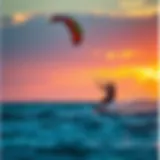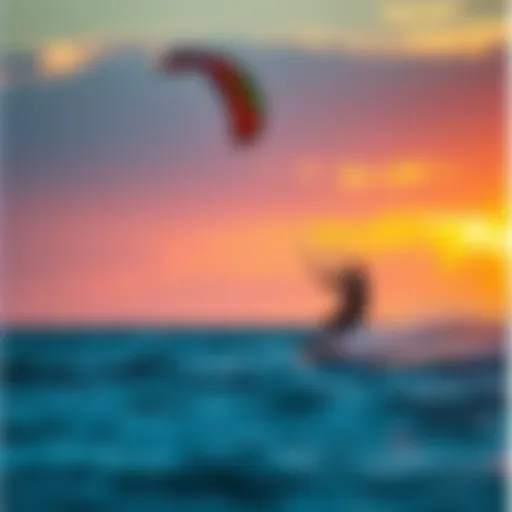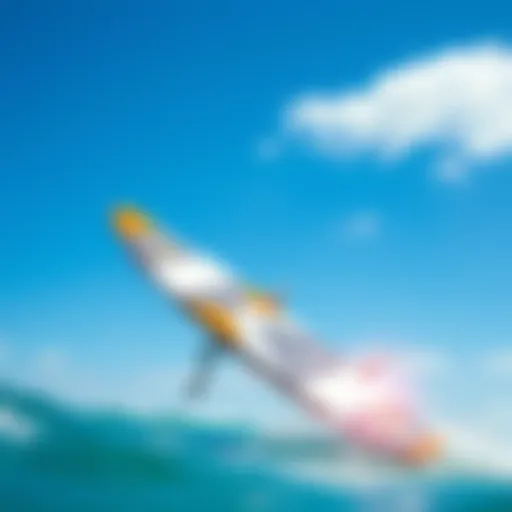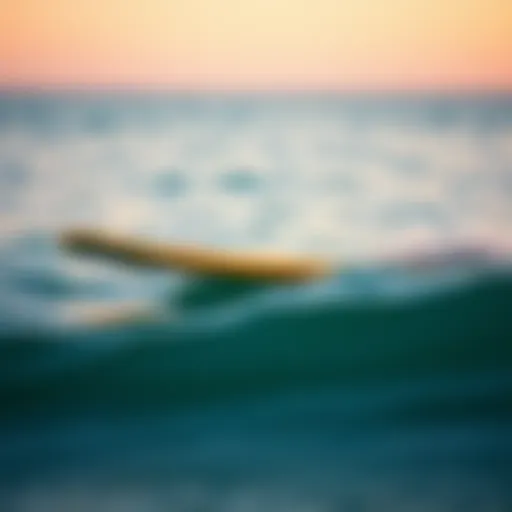Light Wind Kites: Essential Guide for Kiteboarding
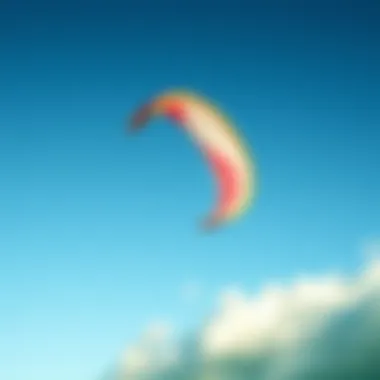

Intro
Light wind conditions can vary significantly; what one person might call light wind, another would deem barely flyable. However, understanding these nuances can make or break an outing. This guide aims to delve into the various aspects that define light wind kites, their optimal use, and how both beginners and advanced kiteboarders can better their game with the right techniques and gear.
The exploration ahead will set the stage for readers to grasp everything from the technical specifications of kites to the essential techniques for harnessing the wind efficiently. By the end of this article, kiteboarders, from novices to those looking to up their skill level, will have a richer understanding of how to navigate light wind settings with confidence and flair.
Understanding Light Wind Kites
Light wind kites represent a specialized subset of kiteboarding gear designed to maximize performance under gentler wind conditions. These kites serve a vital purpose for enthusiasts, opening the sport up to those conditions where traditional kites might falter. With a deeper understanding of light wind kites, kiteboarders can not only enhance their riding experience, but they can also improve their skills in a broad range of environments.
When navigating through the intricacies of light wind kites, it becomes apparent that their design, capabilities, and corresponding techniques differ significantly from their stronger-wind counterparts. Comprehending aspects such as the definition, key features, and their respective advantages ensures that both beginners and seasoned riders can enjoy their time on the water without hindrance from the breeze—or lack thereof.
By embracing the specialized nature of light wind kites, individuals can unlock a world of kiteboarding opportunities. The following sections will delve into key elements, including definitions, purposes, and critical characteristics that make light wind kites a popular choice among practitioners.
Definition and Purpose
A light wind kite is specifically crafted to perform efficiently in low-wind scenarios, often characterized by wind speeds below 15 knots. While traditional kites may poorly respond to such conditions, light wind kites are engineered to maximize lift and provide better control, ensuring a sustained ride. Their purpose extends beyond mere enjoyment; they allow for practice, experimentation, and skill enhancement when challenging wind conditions arise.
Key Features of Light Wind Kites
Several features set light wind kites apart from their conventional counterparts. Understanding these attributes can help kiteboarders make informed decisions and effectively harness their potential.
Size and Shape Variability
The size and shape of light wind kites play critical roles in their ability to catch even the faintest of breezes. Typically, they feature a larger surface area that grants enhanced lift while utilizing minimal wind power. Variability in shape, ranging from delta to bow kites, influences how the kite interacts with the wind. This adaptability makes light wind kites an appealing choice for those looking to stay afloat less gusty weather.
- Key Characteristics: Large wingspan, varying designs.
- Benefits: Improved lift, steady performance at low velocities.
- Unique Features: The varying shapes allow for smoother control which reduces the chances of stalling.
Material Considerations
Using the right materials is paramount in crafting light wind kites, impacting both their durability and performance. High-quality fabrics and lightweight constructions make it easier for these kites to catch soft winds. Additionally, innovative materials often emphasize a balance between weight and strength, ensuring the kite can withstand not only low wind but also occasional gusts when conditions are a bit unpredictable.
- Key Characteristic: Lightweight fabric designed for low resistance.
- Benefits: Enhanced durability, allowing for consistent use over time.
- Unique Feature: Materials like ripstop nylon or polyester are commonly used, providing an excellent compromise between weight and sturdiness.
Aspect Ratio Importance
The aspect ratio of a kite greatly influences its flight characteristics, particularly in light wind scenarios. A higher aspect ratio generally translates to longer, narrower kites that exhibit more efficient aerodynamics. This feature is particularly advantageous when harnessing light winds, as it allows for improved glide and speed.
- Key Characteristic: Longer wingspan compared to the width.
- Benefits: Greater efficiency, allowing for sustained flight even with minimal wind.
- Unique Feature: A well-designed high aspect ratio kite can soar effortlessly, providing the rider a smoother experience even in less-than-ideal conditions.
Advantages of Light Wind Kites
Light wind kites have become a pivotal aspect of kiteboarding, especially for those who want to explore the sport without being at the mercy of stronger winds. Understanding the advantages they bring to the table helps both beginners and veterans make informed decisions regarding their kite choices. This section delves into the specific benefits of using light wind kites and why they are essential for maximizing enjoyment and performance in lower wind conditions.
Enhanced Lift and Efficiency
One of the most crucial benefits of light wind kites is their ability to generate lift efficiently in lighter conditions. This efficiency is not just an afterthought; it’s engineered through optimal design features that allow these kites to harness the smallest breezes. For example, the larger surface area of these kites captures more wind, offering improved uplift even when the wind speed is scanty. The aspect ratio plays a significant role here, as higher aspect ratios lead to reduced drag and better lift.
When you’re out on water and feel that gentle breeze trickling in, you want a kite that’s ready to make it count. You may find that a kite like the Slingshot Rally Lite gives you that instant response to subtle wind shifts, allowing for smoother rides. With these kites, even minor adjustments in body position or steering can lead to significant gains in lift, making each ride a thrilling experience even when conditions aren’t at their peak.
"In light winds, finding that sweet spot between kite control and wind capture is key for a satisfying day on the water."
Accessibility in Gentler Conditions
Light wind kites make the sport increasingly accessible to a broader audience. Traditional kiteboarding often requires robust wind conditions that can overwhelm less experienced riders. But with light wind kites, newbies can step into the sport without feeling like they’re navigating a storm. These kites allow riders to learn the ropes gently.
Another significant aspect of accessibility is the variety of environments where light wind kiting is feasible. Whether you’re on a tranquil lake, a wide-open beach, or even coastal areas where the wind can flicker in and out, light wind kites adapt well to these settings.
Consider this: destinations like the Outer Banks in North Carolina or Maui in Hawaii often have periods of light wind that can frustrate traditional kiteboarders. However, those with light wind kites can take advantage of those conditions, turning what might be a wasted day into a delightful experience.
In summary, the benefits of light wind kites extend far beyond just capture of wind; they foster an environment where riders can thrive, learn, and enjoy kiteboarding in whatever nature throws at them.
Selecting the Right Light Wind Kite
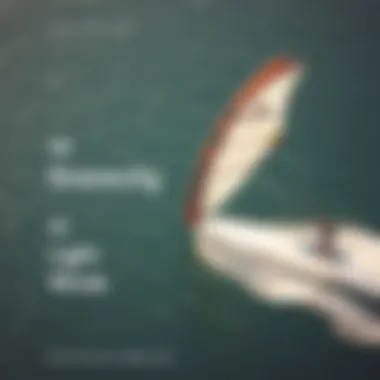

Choosing the right light wind kite is a critical step for anyone looking to make the most of their kiteboarding experience. Light wind kites are specially designed to perform well in gentler breezes, and selecting the right model not only elevates your performance but also enhances your enjoyment on the water. The importance of this topic lies in understanding that not all kites are created equal, particularly in lighter conditions.
Factors such as size, design, and manufacturing materials can have a significant impact on how well your kite handles in mild winds. Comprehending these elements helps you make informed decisions, ensuring the kite you choose will meet your needs and preferences. Perhaps most importantly, a well-suited light wind kite can open up new opportunities for riding, pushing the boundaries of where and when you can kite.
Sizing Considerations
When it comes to light wind kites, size is crucial. Generally, larger kites catch more wind and generate greater lift. However, opting for an excessively large kite can make it challenging to control, especially when navigating tricky conditions. Here are some guiding pointers:
- Weight of the Rider: Heavier riders may require larger kites to harness sufficient power, while lighter riders might manage with smaller options.
- Wind Conditions: Pay close attention to the average wind speeds in your chosen location. If winds are often below ten knots, a larger kite is advisable.
- Skill Level: Beginners might benefit from a kite that offers greater stability and ease of control, meaning a slightly larger size can actually work in favor.
Finding the right balance in size can be daunting. A good rule of thumb is to consult with experienced riders or consider recommendations from reputable shops.
Brand Comparisons
A thoughtful selection of brand can also make a decisive difference in your kiteboarding experience. Each brand often brings unique attributes and advanced technology to their products, and understanding these distinctions can help you make a more educated choice.
Leading Brands in the Market
In the world of light wind kites, few brands consistently stand out for their quality and performance. Notably, brands like Naish, Cabrinha, and Slingshot regularly produce kites that impress users and critics alike.
- Naish: Renowned for their innovative designs, Naish kites often feature high stability and user-friendly handling, making them a favorite among both newcomers and seasoned kiteboarders.
- Cabrinha: This brand is known for its robust construction and performance in a variety of conditions. Their light wind models exemplify strong lift and efficiency, crucial for those seeking maximum enjoyment in lower breezes.
- Slingshot: Their systems typically boast durability and unique features that set them apart. The construction allows for a balance of control and speed, making them a popular choice for those looking for a reliable ride.
Selecting any of these brands can contribute positively to your kiteboarding journey, though personal preference and specific needs should guide your final choice.
Price Points and Value Assessment
The investment in a light wind kite shouldn't be taken lightly. Price points vary significantly across models and brands, each offering its own value proposition.
- Entry-Level Kites: Generally priced lower, catering to beginners. While they might lack advanced features, they provide a solid introduction to the sport.
- Mid-Range Options: Offer a balance between quality and performance, often providing enhancements like better materials or design features without breaking the bank.
- High-End Models: Typically equipped with the latest technology, these kites can be quite pricey. However, they might provide a substantial performance advantage for committed kiteboarders.
Consider what aspects are most important to you. Value may not always correlate directly with price. Evaluate whether the kite offers benefits that align with your skill level, riding goals, and frequency of use.
Techniques for Light Wind Kiteboarding
Navigating the world of light wind kiteboarding demands a blend of skill and understanding of specific techniques. Light wind conditions can often be a puzzle, where standard riding practices may falter. With the right techniques, however, kiteboarders can maximize their experience, harnessing the wind effectively even when it seems lacking.
The techniques described below facilitate a stronger connection between rider and kite, allowing for better control and maneuverability. Furthermore, they can enhance the enjoyment and reduce the frustrations that sometimes accompany riding in lighter conditions.
Fundamental Riding Techniques
Creating Power with Light Winds
Creating power in light winds is essential for successful kiteboarding. The art of generating lift even when gusts are scarce can be quite tricky. Understanding this aspect plays a significant role in maintaining speed and progress on the water.
One key characteristic of creating power is the angle of attack. The kite should be flown closer to the edge of the window, allowing it to catch any breeze available. This brings about a more dynamic lift that can be beneficial when trying to accelerate. When sufficiently understood, creating power becomes almost second nature, which is appreciated by both beginners and experienced riders alike.
The major advantage here is the ability to ride steadily, even against minimal wind. However, overreliance on power generation can lead to over-stressing gear or generating erratic movements on the water. That said, understanding this technique can be a game changer for many.
Body Positioning for Stability
Body positioning is fundamental in achieving stability while kiteboarding, especially on lighter winds. Proper alignment can make a world of difference in how effectively a rider interacts with the kite.
One notable aspect of body positioning is the rider’s center of gravity. Keeping the body low, with knees bent and weight centered over the board, aids in maintaining control and balance during rides. This technique proves particularly beneficial when the wind is lighter, as it allows for quicker adjustments should conditions fluctuate unexpectedly.
Additionally, to prevent undue strain on the back, moving the hips forward can ease tension and distribute weight evenly across the board. Although adapting to this positioning may take practice, riders often find it can improve their stability and confidence immensely.
Advanced Maneuvers
Advanced techniques, while requiring a deeper skill set, are crucial for elevating a rider’s performance in light wind conditions. These maneuvers can differentiate a proficient kiteboarder from an average one, paving the way for smoother rides and greater satisfaction on the water.
Transitions in Minimal Wind
Transitions are a skill often underappreciated, especially in lighter conditions. Understanding how to perform them effectively can result in seamless changes from one direction to another, allowing for fluidity in movement. Key characteristics include the timing of edge changes and the kite’s position in the window, which can minimize turbulence during the maneuver.
What sets transitions apart is their role in maintaining momentum. In light winds, every edge and turn counts; skillful transitions can keep a rider’s speed afloat. Importantly, less resistance during these turns also reduces the strain on the rider.
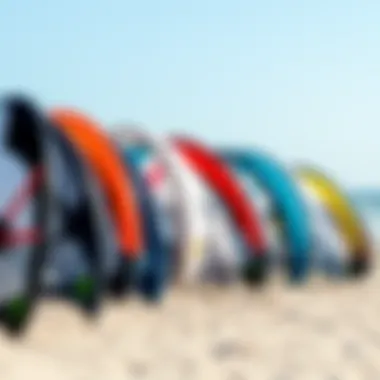

However, attempting transitions improperly, especially in a challenging wind scenario, can lead to being left behind or unnecessary resistance, which can disrupt flow.
Jumping Techniques with Light Kites
The thrill of jumping is a hallmark of kiteboarding, but executing jumps in light winds brings unique challenges. A crucial component of successful jumping is timing—specifically, coordinating the kite’s position with rider movement.
In light winds, the jump often relies on the kite’s ability to create lift rather than sheer force. Riders must learn to draw up the kite swiftly while simultaneously pulling on the handle to achieve a gentle yet effective pop. This characteristic makes jumping a sought-after skill in this discipline—it allows excitement and engagement, even when the wind is less than ideal.
The primary advantage of jumping in light winds is the thrill it brings while still keeping the rider in control. The downside, however, is that not all light kites are built for lofty jumps. Thus, a rider must ensure their equipment is up to par and suitable for such feats.
By mastering these techniques, one can truly stretch the boundaries of what’s possible in light wind kiteboarding, elevating the riding experience beyond basic maneuvers.
Locations Ideal for Light Wind Kiteboarding
Finding the right places to engage in light wind kiteboarding is pivotal for enhancing the overall experience and success of the activity. Not only does a suitable location enhance safety, but it also influences the kite’s performance and the rider’s enjoyment. Carefully chosen spots can offer consistent winds even under lighter conditions.
When considering where to kiteboard, two primary categories emerge: global hotspots and local areas. Each of these come with unique traits that can either facilitate or hamper the kiteboarding adventure.
Global Hotspots
Tropical Destinations
Tropical destinations are often viewed as the paradise for kiteboarders. With consistent trade winds and warm waters, these locations provide the ideal conditions for enjoying kitesurfing in light winds. A key characteristic that favors these areas is the predictable weather patterns found here. For instance, places like the Bahamas, with its azure waters, become extremely appealing not just for their beauty but also for their reliable winds from November to June.
Moreover, the shallow waters in these regions often allow for a more forgiving learning environment, helping novices get up to speed without too much hassle. However, while the allure of nature plays a big part, it’s crucial to be mindful of tropical storms which can pop up unexpectedly, influencing safety.
The major advantage of tropical destinations lies in the accessibility to things like kiteboarding schools and rental services, making them a popular choice not just for seasoned kiteboarders but also for beginners looking to refine their skills.
"The right spot not only eases your kitesurfing but also opens doors to community and learning experiences."
Local Lakes and Coastal Areas
Alternatively, local lakes and coastal areas often serve as reliable venues for light wind kiteboarding. Lakes, in particular, can present a unique advantage—they tend to be less turbulent than coastal conditions, thus offering a smoother ride. A prominent instance is Lake Huron in Michigan, where consistent breezes create a suitable environment for light wind enthusiasts.
These areas are often less crowded than tropical hotspots and may not require extensive travel. Additionally, since they are frequently located near urban centers, kiteboarders might find it easier to arrange convenient day trips.
Nevertheless, potential obstacles can arise, such as limited access to wind when compared to ocean settings. Local winds may be inconsistent, depending on geographical elements like terrain and surrounding flora.
Conditions to Look For
The nature of kiteboarding largely depends on the conditions present at any given location. Two significant aspects to keep an eye on are weather patterns and tides.
Weather Patterns
Understanding weather patterns becomes absolutely critical when kiteboarding in light winds. Light winds generally accompany specific meteorological conditions that can differ widely depending upon the geographical location. For example, coastal areas after a storm can often see lighter wind conditions as atmospheric pressure equalizes.
Factors like approaching cold fronts can bring the winds needed to enjoy a good session. Additionally, a kiteboarder should respect wind forecasts and satellite data to enhance decision-making leading up to an outing. Having a reliable application or service for checking live wind data, such as Windy or Windguru, can be invaluable for any kiteboarder.
On the downside, varying weather patterns may not always yield the bountiful wind opportunities that kiteboarders seek, leading to possible disappointments.
Tides and Their Impact
Finally, tides are another aspect that kiteboarders must consider. Tidal influences play a significant role in several conditions like the available space to launch and the undercurrents a rider may face once the session starts. In coastal areas, for instance, high tides can sometimes create less predictable wind patterns that can trip up even the most experienced riders.
Riders often find that launching at low tides opens up larger areas for practicing and maneuvering. That said, one must also keep in mind the inherent risks posed by rapidly changing water levels and currents. Knowing the local tidal charts is essential for planning trips effectively.
Thus, understanding the interplay between weather patterns and tides can lead to more informed choices, ultimately making the difference between a good session and a frustrating one.
Ideal spots, clear conditions, and essential knowledge are the trifecta for cultivating rewarding kiteboarding experiences, particularly in light wind scenarios.
Maintenance and Care for Light Wind Kites
Maintaining and caring for light wind kites is crucial for both performance and longevity. Like any piece of sports equipment, regular upkeep can mean the difference between an exhilarating ride and a frustrating fail. Light wind kites are specifically designed to harness power from gentler breezes, and they often come with a delicate balance of materials and engineering. Over time, wear and tear can compromise this balance. Hence, understanding how to care for your kite can ensure you remain steady on the water rather than facing downtime due to damaged gear.
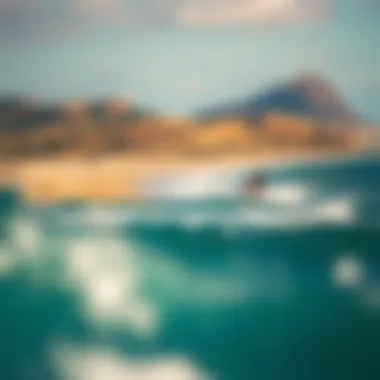

Routine Inspections
Regular checks should become a habit for any kiteboard enthusiast. These inspections help to identify potential problems before they morph into costly repairs or unsafe conditions.
Checking for Wear and Damage
Checking for wear and damage on your light wind kite involves a meticulous examination of seams, fabric, and lines. This process is vital because it ensures the structural integrity of your kite. Perhaps one of the most beneficial aspects of this inspection is that it allows a kiteboarder to catch issues early, which could save time and money in the long run.
- Key Characteristic: The primary focus during this inspection is the material. Light wind kites use lightweight fabrics that, while conducive to upward lift, can be quite prone to fraying or tearing. Catching these issues before the kite hits the water can prevent serious accidents.
- Unique Feature: The advantage of catching weak spots early is obvious. You can address them before a session. However, one disadvantage might be the occasional overzealous inspection leading to unnecessary repairs. You’ll want to balance caution with practicality.
Proper Storage Techniques
Proper storage techniques significantly contribute to the lifespan of your light wind kite. After a long day of kiteboarding, it can be tempting to toss the kite in a corner and call it a day. But this carelessness can lead to unnecessary degradation. Proper storage techniques are a beneficial choice as they help in retaining the kite's original integrity.
- Key Characteristic: A well-stored kite protects it from environmental factors such as UV damage or moisture, which can both compromise the material over time. Storing your kite in a dry, cool place ensures that its lifespan is maximized.
- Unique Feature: One of the advantages of proper storage is the decreased likelihood of needing repairs. Yet, on the flip side, lack of proper storage could lead to inconvenience when preparing for your next outing, as you might first need to clean and dry your kite before use.
Repairing Common Issues
Even with diligent care, issues can arise that require repair. Rather than taking it back to the shop for every small issue, it’s worthwhile to learn how to handle common repairs yourself.
Identifying Weak Spots
Identifying weak spots in your kite can be an art and a science melded into one. This process involves scrutinizing the kite fabric and connections where stress is most likely to occur. It's a beneficial practice as it helps kiteboarders maintain peak performance.
- Key Characteristic: Most wear and damage occur in areas such as the leading edge or the trailing edge of the kite, where tension is highest. Being vigilant about these areas can help prevent bigger issues down the line.
- Unique Feature: Early recognition of weaknesses can lead to timely repairs, ensuring the kite remains reliable when you hit the water. However, you might find that if you don’t have the right techniques, you could potentially worsen the damage unintentionally.
DIY Repair Solutions
DIY repair solutions offer an economical and immediate way to manage kite issues. Having knowledge of how to fix minor tears or replace damaged lines can keep you on the water longer, which is what every kiteboarder desires.
- Key Characteristic: Many DIY solutions involve simple kits that include patches and line replacements. This makes it an accessible option for most riders. Being able to address repairs quickly means less time spent waiting and more time riding.
- Unique Feature: An advantage of doing your own repairs is the satisfaction it brings. Many kiteboarders enjoy the hands-on approach to their gear. However, one must also be cautious, as improper repairs may fail during use, potentially leading to risky situations.
Proper maintenance and care of your light wind kite can enhance your experience, ensuring safer adventures and optimizing performance.
By focusing on these aspects of maintenance and care, every kiteboarder can extend the life of their gear while maximizing their experience on the waves, allowing them to enjoy those gentle breezes to the fullest.
Emerging Technologies in Light Wind Kites
In the world of kiteboarding, especially in light wind conditions, advancements in technology are not just helpful; they can mean the difference between a frustrating day on the water and an exhilarating experience. Emerging technologies are reshaping the way kite surfers engage with their sport, enhancing performance and broadening the accessibility of kiteboarding for all skill levels. Understanding these innovations can enrich one's strategy and selection process, providing kite enthusiasts with tools to navigate light winds remarcably well.
Innovations in Material Science
The very heart of kite design lies in the materials used to construct them. Recent breakthroughs in material science have introduced lighter, more durable fabrics that improve both lift and responsiveness. This is critical for light wind kites, where every bit of material weight dramatically affects performance.
For instance, the adoption of ripstop nylon has become widespread due to its strength-to-weight ratio. Unlike traditional fabrics, ripstop nylon includes a grid of reinforced threads that prevents tearing and enhances durability. This means that kiteboarders can feel more confident even when conditions aren’t ideal.
"Using lighter materials allows for greater freedom of movement and responsiveness, crucial for harnessing light winds effectively."
Another noteworthy material is Dyneema, which is notably stronger than steel but incredibly light. Kites designed with Dyneema contribute to enhanced performance in lighter winds, allowing riders to maintain control and move efficiently. This innovation showcases how material science isn't just about weight; it's about reimagining what's possible when designing kites for specific conditions like light wind environments.
Performance Enhancements
Performance enhancements have parallels in other sports equipment, but kiteboarding's unique demands require particular solutions. The advancements here add capabilities that can significantly improve the kiteboarding experience, especially in light winds.
Smart Sensors for Kite Performance
Smart sensors are becoming a game-changer in kiteboarding. These technological pearls can monitor various variables such as wind speed, angle, and even the kite's position in real-time. This feedback loop allows riders to make informed decisions on the water, adjusting their techniques to maximize power and control.
One key characteristic that sets these sensors apart is their ability to transmit data directly to applications on smartphones, providing instant analysis and performance feedback. This integration helps both novices and seasoned riders fine-tune their techniques, making learning more efficient.
However, while these sensors present several advantages, they do come with drawbacks. The reliance on technology might lead some riders to rely less on their instincts and experiences. Balancing this tech with traditional skills is paramount. Nonetheless, for those pursuing improvement, these sensors provide a clear edge in understanding and adapting to the nuances of light winds.
Adaptive Aerodynamics
Adaptive aerodynamics signify a significant leap in kite performance. This innovation revolves around the ability of a kite to adjust its shape and surface area dynamically, responding to fluctuating wind conditions. For light wind conditions, where power can be scarce, this feature becomes invaluable.
The unique capability of adaptive aerodynamics lies in its design that allows for real-time changes in performance characteristics. Riders can experience better lift and control without having to change kites as often. This adaptability saves time and enhances enjoyment since you won’t be constantly swapping equipment just to find that perfect kite.
However, the complexity of these kites can also pose challenges — they might require more maintenance or adjustments than traditional setups. Understanding how to work with these kites effectively is essential for the rider wanting to harness their full potential in light wind situations.
Whether looking at material science or the wonders of adaptive aerodynamics, the world of light wind kites is evolving. Embracing these advancements allows kite surfers to elevate their game, transforming how they ride the waves and play with the winds.
